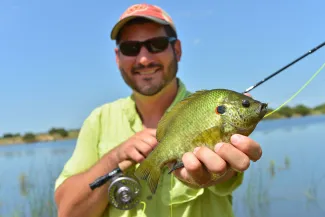This section will focus on management strategies for pond owners desiring a balanced largemouth bass-bluegill-sunfish population. Channel catfish may also be added to these ponds. This is the most desirable management scheme for the vast majority of pond owners because it supports the widest variety of sportfish, allows catch and harvest of greater quantities of fish, and is the easiest to keep in balance. Strategies for a balanced bass-bluegill fishery are detailed below under (1) New or Reclaimed Ponds, and (2) Ponds With Existing Fish Populations.
Balanced Fish Populations
- Bass range in size from eight to 15 inches or more; about one-third to two-thirds are 12 or more inches long; their body condition is good, i.e. they are not skinny.
- Bluegill and other sunfish are four to eight inches long or longer; about one-half to three-fourths are at least six inches long; their body condition is good also.
- Channel catfish, if present, range in size from six to 18 inches with one-third to two-thirds being 14 inches long or longer; they are fairly robust.
- Crappie, if present, are five to 10 inches long or longer; one-fourth to one-half of them are at least nine inches long; all are in good body condition.
- A reasonable catch rate would be two fish or more per hour for the species being sought. However, this will vary considerably depending on the time of day, time of year, species of fish, the ability of angler, and a host of other factors.
Overcrowded Bluegill Population
- Most of the bass are longer than 12 inches but not many are caught; they seem to be in good body condition.
- Bluegill, and possibly other sunfish, are very abundant but most are three to five inches in size; they are thin and may appear to have large eyes and heads for their length.
- Channel catfish may be similar to the above or there may be more of the smaller size catfish (perhaps less than eight inches long) in the pond.
- Crappie, if present, may be abundant, small, and skinny.
- This situation is typical in ponds where bass harvest has been excessive in the past. Too few bass are available to control the reproduction of bluegill and other sunfish as well as crappie and possibly catfish. An abundance of small sunfish or crappie can interfere with successful bass reproduction thereafter. This situation usually does not improve with time.
- A variation of this situation can result when excessive vegetation or extreme turbidity prevents bass from eating the small sunfish. In this case, sunfish are abundant and small, as above, but more bass are skinny and perhaps more abundant.

Overcrowded Bass Population
- Bass are very abundant, and few if any are over 12 inches long; they generally are thin but might have good body condition.
- Bluegill and other sunfish are somewhat less abundant but most are well over six inches long; their body condition is excellent.
- Channel catfish, if present, are scarce, and very few are less than eight inches in length.
- Crappie, if present, are mostly nine inches long or longer and are robust.
- This situation occurs when bass reproduction is very high, and therefore each bass has less to eat. Sometimes over harvest of larger bass in a pond can lead to this situation. These conditions are usually ideal for producing large sunfish and crappie because abundant eight- to 12-inch bass are effective predators on small sunfish and crappie.
Other Fish Populations
Of course, many other fish population possibilities exist. A common one might be a catfish-only pond used for recreation or small-scale commercial production of channel catfish. A pond may be used to raise ornamental fish, hybrid sunfish, or trophy bass, for example. However, these special types of pond management do not occur by accident and are not typical farm pond used for recreational fishing. These and other pond management approaches are discussed in other sections of this booklet.
Once pond fish populations have been assessed using catch records and the information presented here, you can select an approach based upon your objectives for that pond. Most of the remainder of this booklet addresses what to do once you know the status of your pond and how you want it managed.